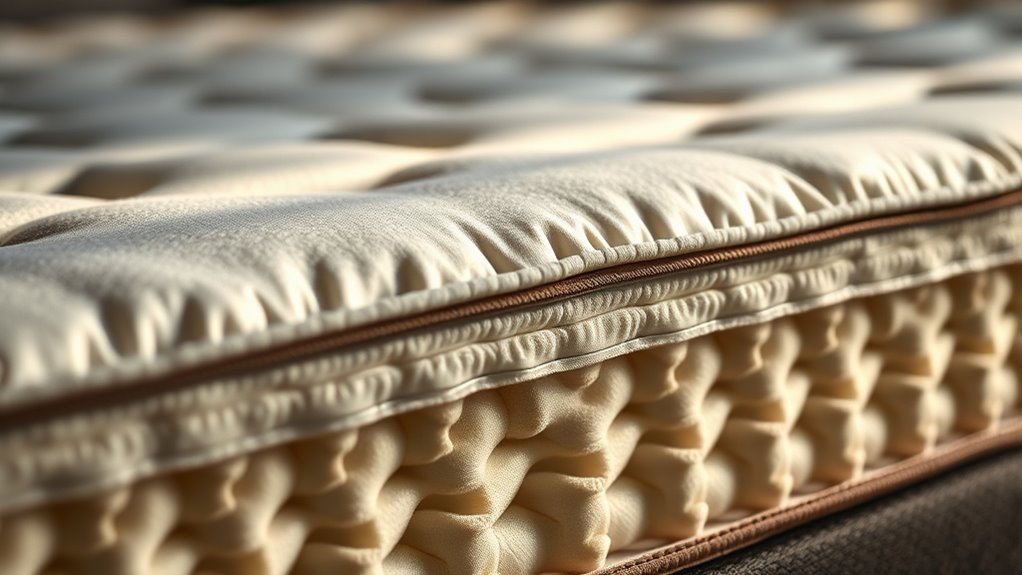The perfect mattress blends advanced materials, like memory foam and pocket springs, with supportive layers that promote proper spinal alignment. It also evenly distributes pressure, reduces hotspots, and regulates temperature through breathable, moisture-wicking fabrics. Many companies overlook how support zones, foam density, and ergonomic design work together for personalized comfort. If you want to uncover the hidden science behind these features and how they impact your sleep, there’s more to discover below.
Key Takeaways
- Material layering and foam density are crucial for tailored support, pressure relief, and durability, often overlooked by manufacturers.
- Proper spinal alignment depends on targeted support zones and responsive materials that adapt to individual body contours.
- Advanced cooling tech like gel-infused memory foam and phase change materials help regulate temperature and enhance sleep quality.
- Mattress longevity heavily relies on maintenance, rotation, and usage habits, not just initial quality or price.
- Personalization and ergonomic design are vital for optimal sleep, yet many companies prioritize marketing over individualized support solutions.
The Anatomy of a Mattress: Materials and Layers Explored
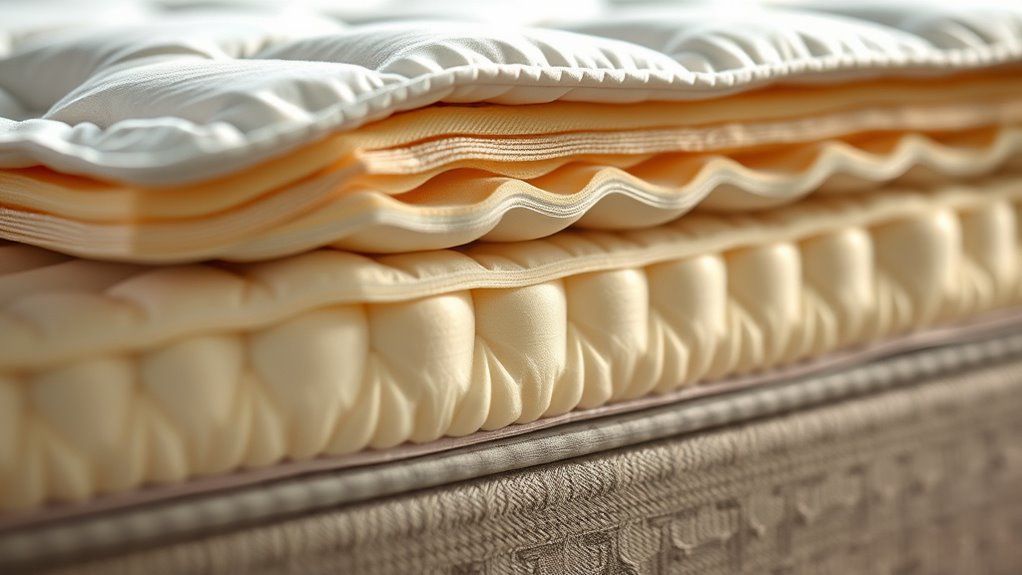
Understanding what makes a mattress comfortable begins with exploring its core components. Memory foam molds to your body shape, providing personalized comfort by evenly distributing pressure and reducing movement transfer. It’s known for its contouring support, which helps align your spine during sleep. On the other hand, pocket springs consist of interconnected coils individually wrapped in fabric pockets. This design allows each spring to move independently, responding precisely to your body’s weight and position. The combination of memory foam and pocket springs creates a balance between softness and support, enhancing comfort while maintaining proper spinal alignment. These materials form the foundation of many high-quality mattresses, but their effectiveness depends on how they’re layered and integrated within the mattress structure. Vetted materials ensure durability and safety, contributing to a better sleeping experience.
How Support and Comfort Are Scientifically Achieved
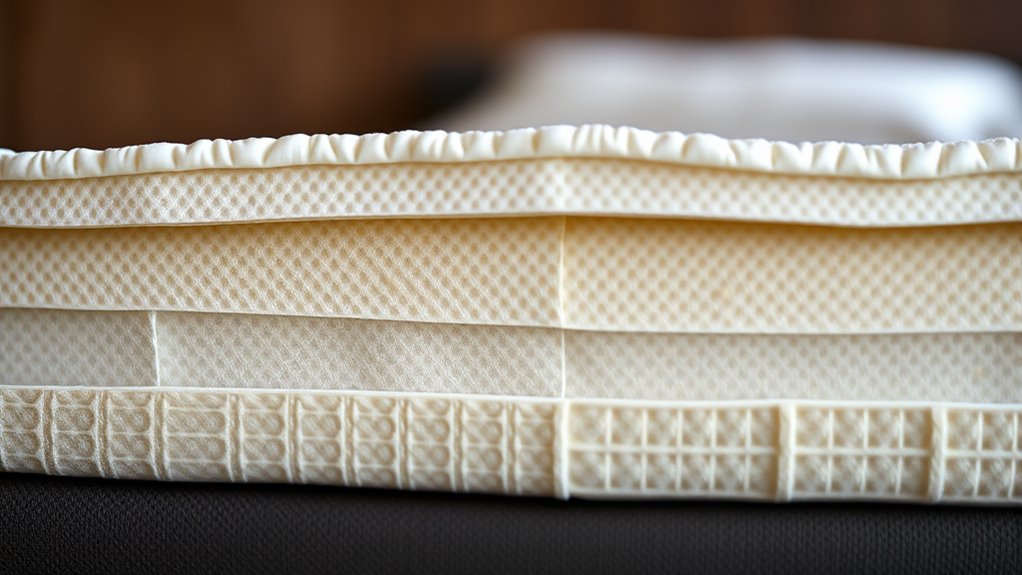
Support and comfort in a mattress are achieved through the precise interplay of materials and design, which work together to respond to your body’s unique shape and movements. Foam density plays a pivotal role by determining how well the mattress supports different areas of your body. Higher foam density offers better support and durability, especially in key support zones like the hips and shoulders. These zones are strategically designed to provide targeted reinforcement, ensuring proper spinal alignment and weight distribution. Meanwhile, softer zones allow for pressure relief in sensitive areas. This combination creates a balance between support and comfort, enabling your body to maintain a natural posture throughout the night. Incorporating natural materials can also enhance breathability and overall sleep quality. Understanding how foam density and support zones work together helps you choose a mattress tailored to your needs.
The Role of Spinal Alignment in Sleep Quality

Proper spinal alignment during sleep is key to feeling rested and avoiding discomfort. When your spine maintains its natural curve, you support spinal health and reduce strain on muscles and joints. Misalignment can lead to aches, stiffness, and long-term posture issues. A mattress that promotes proper posture correction guarantees your spine stays aligned from your neck to your lower back throughout the night. This alignment helps prevent pressure points and minimizes tossing and turning. When your spine is properly supported, you wake up feeling more refreshed and free of pain. Investing in a mattress that encourages spinal health isn’t just about comfort; it’s about safeguarding your posture and overall well-being. Good spinal alignment during sleep is essential for restorative rest and long-term health. Incorporating sound design principles, such as selecting the right materials and construction techniques, can also improve a mattress’s ability to support proper alignment.
The Impact of Pressure Distribution on Restorative Sleep
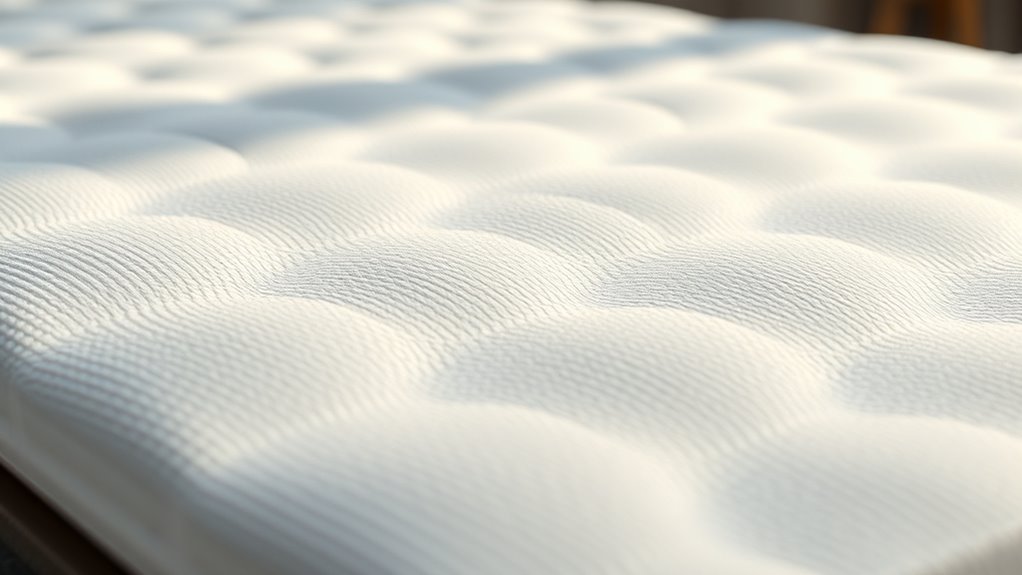
When your mattress evenly distributes pressure across your body, it allows your muscles to relax fully and reduces discomfort that can interrupt your sleep. Pressure mapping studies reveal how different mattresses impact sleep pressure, showing where pressure points build up and cause tossing or turning. Proper pressure distribution minimizes these hotspots, decreasing strain on sensitive areas like hips and shoulders. When you experience balanced support, your body can stay aligned, preventing pain and fostering deeper, more restorative sleep. By reducing localized pressure, your body doesn’t have to work as hard to maintain comfort, allowing your nervous system to relax. Additionally, pressure redistribution supports spinal alignment and reduces the risk of developing pain over time. Ultimately, a mattress that promotes ideal pressure distribution helps you fall asleep faster and enjoy uninterrupted sleep, leading to better recovery and overall well-being.
Temperature Regulation and Breathability in Mattress Design
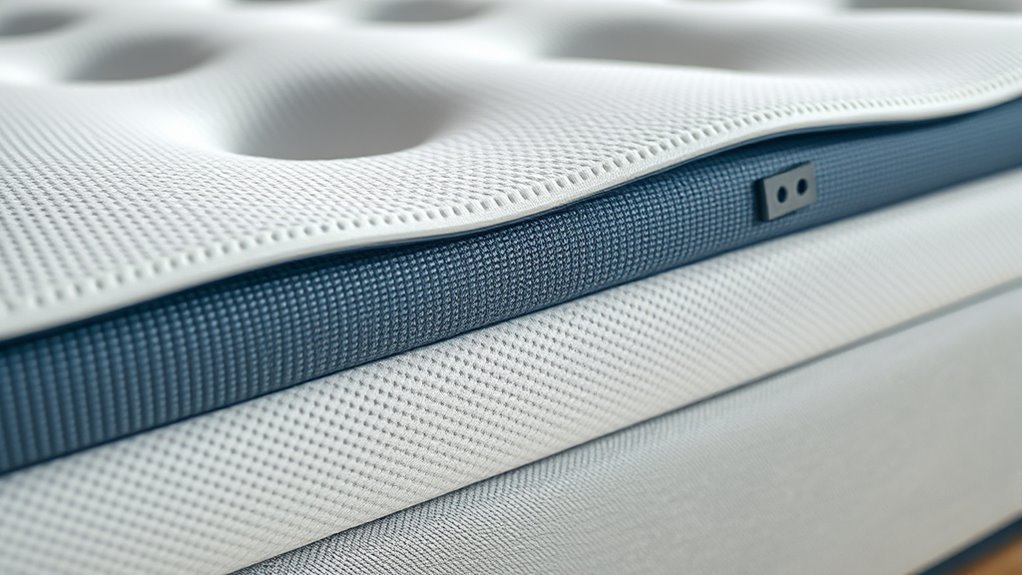
To stay comfortable all night, your mattress needs effective temperature regulation and breathability. Material choices like ventilated foam and breathable fabrics help air flow and prevent overheating. Layered cooling technologies and moisture-wicking fabrics further enhance airflow and keep you dry throughout your sleep. Incorporating breathability features into mattress design can significantly improve overall comfort and sleep quality.
Material Choices for Ventilation
Choosing the right materials for mattress ventilation is essential for maintaining a comfortable sleep environment. Memory foam, while popular for support, can trap heat if not properly ventilated. To combat this, many manufacturers now use gel-infused memory foam, which helps dissipate body heat and promotes breathability. This material choice allows air to circulate more effectively, reducing heat buildup throughout the night. Additionally, gel particles absorb and transfer heat away from your body, keeping you cooler. When selecting a mattress, look for those made with gel-infused memory foam or other breathable materials designed to enhance airflow. Proper ventilation isn’t just about comfort—it also helps regulate temperature and prevents overheating, ensuring you wake up refreshed and ready for the day. Regular filter maintenance and choosing models with HEPA filtration can further improve indoor air quality and support healthier sleep environments.
Layered Cooling Technologies
Layered cooling technologies combine multiple design elements to optimize temperature regulation and airflow within a mattress. Gel memory foam is often included because it absorbs and disperses heat, helping you stay cool throughout the night. You might also find phase change materials integrated into the layers; these materials actively respond to temperature changes by absorbing excess heat and then releasing it when you cool down. This dynamic process keeps your body at an ideal sleeping temperature. Additionally, hydration plays a crucial role in maintaining optimal brain and body function, which can be supported by proper mattress design. By layering these cooling elements, mattress manufacturers enhance breathability and prevent heat build-up. The result is a mattress that adapts to your body’s needs, reducing overheating and promoting uninterrupted sleep. Layered cooling technologies are essential for those who want a cooler, more comfortable sleep experience.
Moisture-Wicking Fabrics
Have you ever wondered how some mattresses stay dry and cool all night? The secret lies in moisture-wicking fabrics, which enhance temperature regulation and breathability. These fabrics are designed for better moisture control, helping you stay comfortable. Here’s how they work:
- They draw sweat away from your skin, keeping you dry.
- They promote airflow through the fabric, preventing heat buildup.
- They dry quickly, reducing the risk of mold and odor.
Many sleepwear fabrics use moisture-wicking technology, and this principle extends to mattress covers and fabrics. By integrating moisture-wicking materials, mattress companies improve sleep quality, especially for hot sleepers. The right moisture control can make a noticeable difference, ensuring you wake feeling refreshed rather than sticky or overheated. Additionally, advancements in fabric technology are influenced by ongoing research into AI-driven innovations, which help optimize material performance and durability.
Common Myths and Misconceptions About Mattress Durability
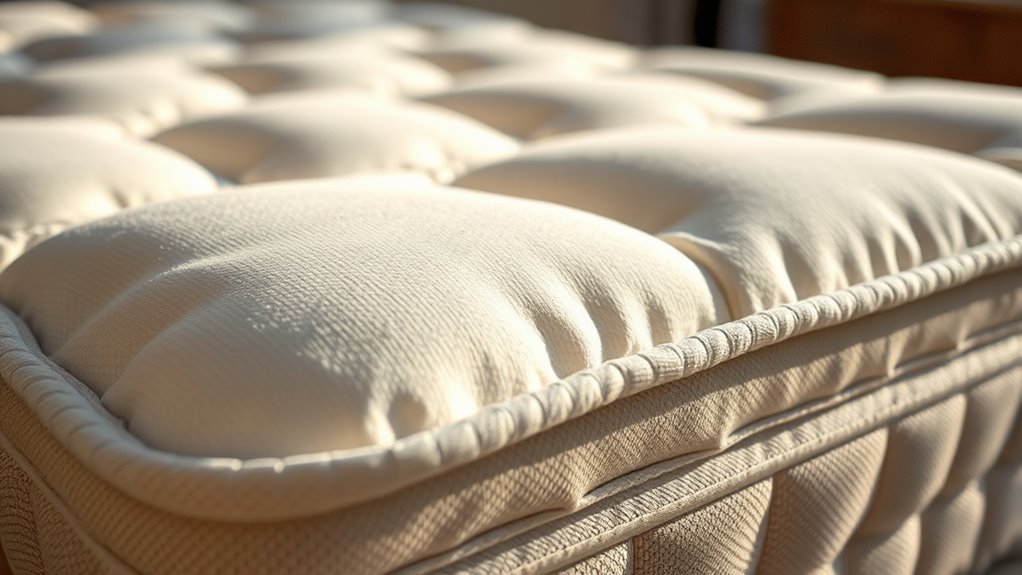
Many people believe that a mattress’s durability depends solely on its initial quality, but this isn’t always true. Durability myths often lead you to assume that high-quality materials guarantee a longer lifespan, but material longevity can vary based on usage and care. For example, a mattress made with premium foam might still sag prematurely if you don’t rotate it regularly. Conversely, a less expensive mattress can last longer if you follow proper maintenance. Don’t fall for the misconception that all mattresses with sturdy-looking materials are equally durable. Instead, consider how daily wear, weight distribution, and cleaning habits impact longevity. Understanding these factors helps you choose a mattress that remains supportive and comfortable over time, rather than relying solely on initial material quality.
The Importance of Ergonomics and Personalization in Choosing a Mattress
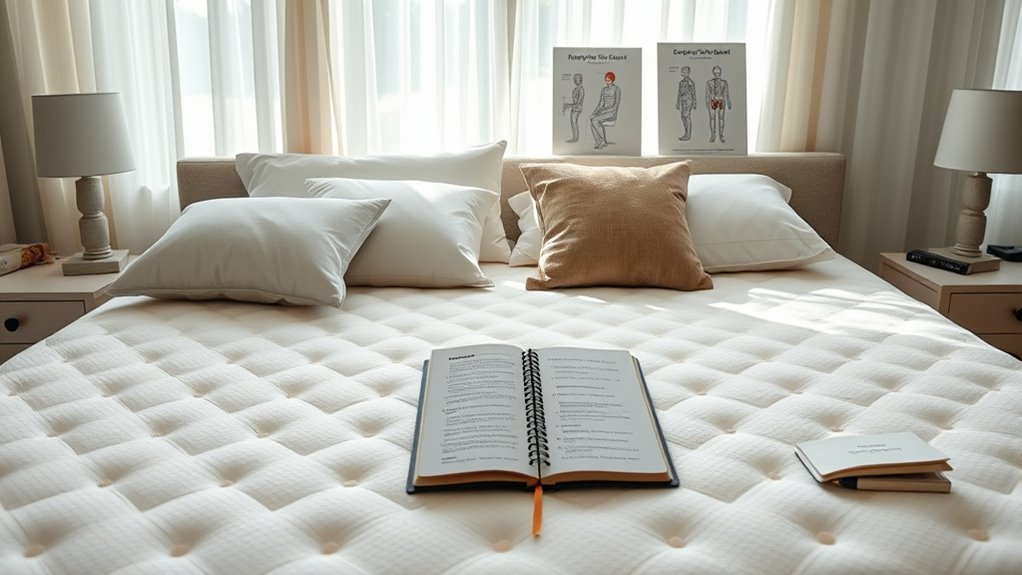
Since everyone’s body is unique, choosing a mattress that offers proper ergonomics and personalization is essential for a good night’s sleep. An ergonomic design supports your spine’s natural alignment, reducing aches and discomfort. To find the right fit, consider these key factors:
- Support zones: Look for a mattress that adapts to your body’s curves, providing targeted support where needed.
- Adjustable firmness: Personalize your comfort level to match your sleeping position and preferences.
- Material responsiveness: Choose materials that conform to your body, offering personalized comfort and pressure relief.
Prioritizing ergonomic design and customization guarantees your mattress promotes better sleep quality, helping you wake up refreshed and pain-free.
Frequently Asked Questions
How Do Different Mattress Materials Affect Long-Term Health Risks?
Different mattress materials can impact your long-term health risks by introducing allergy triggers and chemical emissions into your sleep environment. If you choose foam or synthetic fabrics, you might expose yourself to chemicals that cause respiratory issues or skin irritation over time. Natural materials like latex or organic cotton tend to emit fewer chemicals, reducing the risk of allergy triggers and promoting better overall health. Always consider these factors when selecting your mattress.
What Hidden Factors Influence a Mattress’s Ability to Regulate Temperature?
Imagine your mattress as a thermostat, where hidden factors like material density and airflow act as secret guardians of temperature regulation. You might not see the heat retention trapped within layers or the breathability of fabrics, but they silently influence your comfort. These subtle elements determine if your mattress keeps cool or traps heat, impacting your sleep quality. Stay aware of these hidden factors for a better, cooler night’s rest.
Can Mattress Design Impact Sleep Quality Beyond Comfort and Support?
You might not realize it, but mattress design impacts sleep quality beyond comfort and support. Proper pressure distribution helps prevent aches and reduces tossing and turning, while minimizing motion transfer allows you to sleep undisturbed even if your partner moves. These factors contribute to deeper, more restorative sleep, so choosing a mattress that addresses them can substantially improve your overall sleep experience and wake you feeling refreshed.
Are There Scientifically Proven Features That Extend a Mattress’s Lifespan?
You want a mattress that lasts longer, and scientifically proven features can help. Look for memory foam with high-density layers, which resist sagging and maintain support over time. Organic materials like natural latex and cotton also enhance durability by resisting wear and mold. These features work together to extend your mattress’s lifespan, ensuring you get the most value and comfort from your investment for years to come.
How Do Personal Sleep Positions Influence Optimal Mattress Choice?
Ever wondered how your sleep posture affects your mattress choice? Your sleep position influences mattress alignment needs—side sleepers often benefit from a softer surface to cushion shoulders and hips, while back sleepers prefer firmer support to maintain spinal alignment. Stomach sleepers require a balanced firmness to prevent neck strain. By selecting a mattress that supports your sleep posture, you’ll improve comfort, reduce pain, and guarantee better sleep quality every night.
Conclusion
Now that you’re armed with the science behind the perfect mattress, you can make a smarter choice—no need to consult a wizard or rely on old wives’ tales. Remember, just like a finely tuned lute, your mattress should support your body’s unique rhythm and needs. Don’t let myths deceive you; instead, trust in the knowledge that modern science, much like a trusty compass, guides you toward restorative, restful sleep every night.
